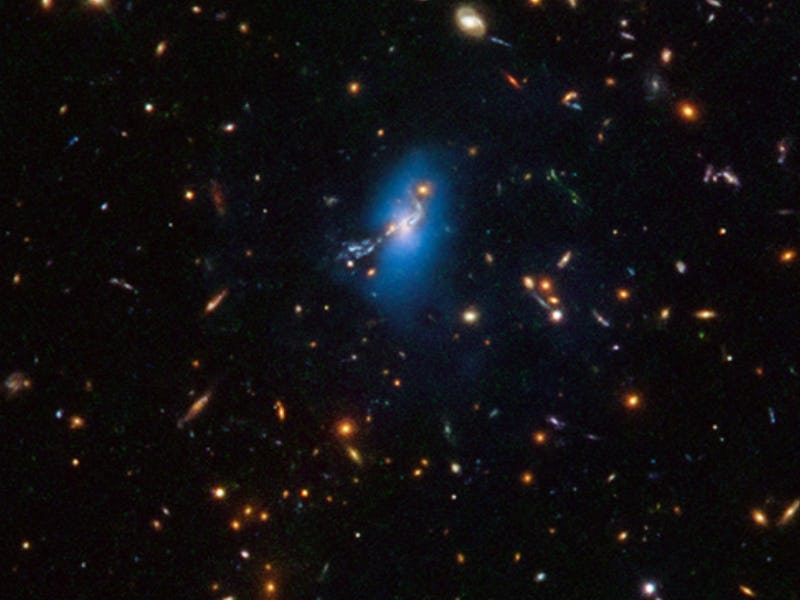Hubble studies 10 billion year old ghost light from lost stars
Space is haunted, sort of.

The universe’s biggest, brightest galaxy clusters are haunted. In the dark, empty corridors between galaxies, lost stars wander, filling the blackness with a faint, ghostly light.
Imagine looking up at a night sky devoid of stars; you see only blackness, sparsely dusted with the tiny, dim blurs of distant galaxies and the lonely lights of a handful of other planets that also orbit your isolated sun. That’s what it would be like to live on a planet orbiting a star that drifts through space alone, outside the embrace of a home galaxy. And a recent Hubble Space Telescope survey suggests that these lost stars have haunted intergalactic space for billions of years.
Astronomers Hyungjin Joo and James Jee, both of Yonsei University, published their findings in the journal Nature.
What’s New — Hubble recently looked at 10 galaxy clusters — groups of hundreds or even thousands of galaxies, each home to billions of stars, all bound together by their shared gravitational pull — ranging from the nearest neighbors of our own Local Group to a distant cluster 10 billion light years away. In each of those clusters, the galaxies blaze brightly, but an eerie haze of dim light surrounds the whole cluster. That haze is the light of many stars adrift in intergalactic space, doomed to wander alone between galaxies.
This Hubble Space Telescope image shows a distant galaxy cluster. The blue haze is artificially added from Hubble infrared data, which measured the light from stars wandering solo through intergalactic space.
From here on Earth, that ghostly light is extremely faint, about .01 percent as bright as the whole night sky. But with its powerful instruments, and in the longer wavelengths of infrared light, Hubble was able to study the faint glow of lonely stars in more detail. Astronomers wanted to know whether those stars were recently ripped from the warmth and light of their home galaxies amid the violence of galactic collisions, or if they’d been haunting the space between for much, much longer.
It turns out that these stellar lost souls are truly ancient. The amount of a cluster’s light that came from wandering stars, rather than the cheery blaze of galaxies, was the same for nearby galaxy clusters as it was for very distant ones. When we see light from a galaxy cluster 10 billion light years away, we’re seeing that cluster as it looked 10 billion years ago – which means the amount of “ghost light” in big clusters of galaxies has been about the same for the last 10 billion years. If the lost stars became lost due to recent cataclysms, you’d expect to see more ghost light in nearby clusters, but that’s not the case.
“That means that these stars were already homeless in the early stages of the cluster’s formation,” says Jee in a recent statement. “Somehow, they were produced in large quantities in the early universe. In their early formative years, galaxies might have been pretty small, and they bled stars pretty easily because of a weaker gravitational grasp.”
Why It Matters — Because these lonely stars have been haunting intergalactic space in their galaxy clusters for so long, and because the events that set them adrift — galactic collisions and near-misses, among others — probably also played a key role in shaping the clusters, understanding the stars and their fates could help reconstruct the early history of galaxy clusters.
And understanding how galaxy clusters assembled themselves can help us understand why our modern universe looks the way it does.
The ghostly light of lonely stars could also help astrophysicists map the filaments of dark matter that form the invisible scaffolding of galaxy clusters (and everything else). We can’t see dark matter, so scientists have to trace it based on its effects on the stuff we can see. At the moment, the best method for doing that is a trick called gravitational lensing, which relies on the galaxy cluster’s mass being enough to warp spacetime around it, causing light to curve around the cluster instead of shining straight through.
Astronomers used gravitational lensing to produce the first image from the Webb space telescope.
Gravitational lensing turns big galaxy clusters into natural telescopes on a cosmic scale, which has helped actual telescopes like Hubble and the James Webb Space Telescope see farther and fainter objects than they otherwise could. And by comparing the strength of the lens to the amount of visible mass in the cluster, astronomers can figure out how much of the cluster’s mass is invisible: dark matter, in other words.
But the eerie glow of rogue stars could shed more light on dark matter.
“They can serve as visible tracers of dark matter enveloping the cluster,” says Joo in a recent statement.
What’s Next — Webb can see the universe in even longer infrared wavelengths than Hubble can, which means it can see fainter, more distant (and therefore even older) objects. If astronomers can find the light of lonely, wandering stars in the extremely early universe, they can piece together exactly how and when these stars got cast out of their original galaxies.
This article was originally published on